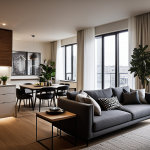Essential minimalist principles for UK interiors
Minimalist decor principles focus primarily on functionality and simplicity. In UK minimalist design basics, every piece of furniture and decor must serve a purpose and contribute to a clean, uncluttered look. This means opting for quality over quantity; rather than filling spaces with many items, select high-quality, durable pieces that elevate the room’s function and aesthetic.
UK homes often have unique proportions—from cozy flats to period houses—so minimalist living UK adapts by balancing these sizes with thoughtful placement. For example, in smaller rooms, choosing furniture with slim profiles maximises space without sacrificing comfort. Plain, simple lines and a restrained colour palette help maintain airiness and clarity.
This might interest you : What are the top tips for selecting UK home furniture?
Minimalism also stresses intentionality: each item should earn its place in the home, ensuring the environment remains calm and organised. This approach aligns with UK minimalist design basics, encouraging homeowners to evaluate each piece’s role. Ultimately, minimalist decor principles tailored to UK interiors create spaces that are both practical and pleasing, supporting everyday living without excess.
Decluttering strategies for a minimalist space
Mastering clutter control enhances minimalist living UK
In the same genre : How Can You Transform Urban Apartments into Cozy Homes with Minimal Effort?
Effective decluttering UK starts with a systematic, room-by-room approach. Begin by sorting items into categories: keep, donate, and discard. This clear separation helps identify essentials and removes unnecessary objects cluttering your space. The key is to be ruthless—only items that serve a purpose or bring joy remain.
For minimalist storage tips, integrate hidden or multipurpose solutions. Furniture with built-in drawers or ottomans offering storage stow belongings discreetly, maintaining clean surfaces. Wall-mounted shelves free up floor space, ideal for small UK homes where every inch counts. Opting for neutral, uniform containers also maintains the minimalist aesthetic by reducing visual chaos.
Long-term organisation for small homes relies on ongoing maintenance. Regularly revisiting each space to reassess belongings prevents clutter accumulation. Establish simple daily habits: returning items after use, periodic donation drives, or seasonal wardrobe edits. This active management supports sustained minimalism without overwhelming effort.
By applying these decluttering UK strategies and embracing smart minimalist storage tips, homeowners can maintain a serene, functional environment that embodies the true essence of minimalist living UK.
Essential minimalist principles for UK interiors
Minimalist decor principles centre on functionality and simplicity, ensuring every element in a UK home serves a clear purpose. UK minimalist design basics prioritise quality over quantity, selecting furniture and decor items that are both durable and aesthetically clean. This approach fosters an uncluttered environment where each piece contributes meaningfully to the overall space.
In adapting minimalist living UK to diverse home styles, it is crucial to respect the unique proportions typical of British residences, from compact urban flats to spacious period properties. For instance, slim-profile furniture helps smaller rooms appear airy without sacrificing usefulness. Meanwhile, clean lines and muted tones maintain visual harmony and support minimalist calm.
Minimalist decor principles also encourage intentional choices: each object should justify its presence through practical use or enhancing tranquillity. By focusing on well-chosen, functional items within a restrained palette, UK minimalist design basics create interiors that feel both practical and serene. This balance aligns with minimalist living UK’s goal to make homes organised and easy to maintain, building a space that supports everyday life naturally.
Essential minimalist principles for UK interiors
Minimalist decor principles emphasise functionality and simplicity in every design choice. In UK minimalist design basics, the focus is on selecting items that serve clear, practical purposes. This avoids clutter while enhancing daily living. A core rule is to prioritise quality over quantity—investing in fewer, well-crafted pieces rather than many decorative but unnecessary objects. Durable furniture with clean lines not only looks elegant but also stands the test of time.
Adapting minimalist living UK to fit varying home sizes and styles is vital. Many UK homes, from compact flats to older period properties, benefit from furniture scaled appropriately to their proportions. Slim-profile sofas or nesting tables can maximise space and maintain flow. Additionally, a restrained colour palette—often muted tones or soft neutrals—supports the calm, uncluttered atmosphere intrinsic to minimalist decor principles.
Intentionality remains key in UK minimalist design basics. Every item should justify its presence by either function or meaningful aesthetics. Together, these principles create interiors that are both efficient and inviting, perfectly suited to the nuances of homes across the UK.
Essential minimalist principles for UK interiors
Minimalist decor principles focus fundamentally on functionality and simplicity. In UK minimalist design basics, every item must serve a clear practical function or enhance the home’s atmosphere without adding clutter. The emphasis lies on quality over quantity, favouring fewer, well-crafted pieces that combine durability with aesthetic appeal. This approach reduces excess and ensures each element earns its place.
Adapting minimalist living UK to diverse residences means respecting the unique proportions typical of British homes. Whether it’s a compact flat or a period house, furniture should be scaled thoughtfully. For example, slim-profile sofas or nesting tables maximise usable space without overwhelming rooms. Choosing subdued, neutral colour schemes further supports a calm, open feel, central to minimalist decor principles.
Intentionality also embeds itself deeply in UK minimalist design basics. Each object’s role—be it function or meaningful simplicity—must be considered carefully. This mindful selection supports an environment that is both purposeful and inviting. By prioritising these fundamentals, minimalist living UK creates interiors that enhance daily life while retaining elegance and ease of upkeep.
Essential minimalist principles for UK interiors
Minimalist decor principles in UK homes hinge on functionality and simplicity, ensuring every element has a clear purpose. UK minimalist design basics encourage selecting fewer pieces but prioritising quality materials and craftsmanship. Investing in durable furniture and decor not only enhances longevity but also contributes to an uncluttered, elegant interior.
A key aspect of minimalist living UK is adapting these ideals to the distinct proportions and character of British residences. For example, compact urban flats benefit from furniture with sleek profiles and multi-functionality, maximising usable space without visual crowding. Conversely, period homes can balance minimalist style with heritage features by choosing restrained, neutral tones and clean-lined pieces that complement rather than compete with architectural details.
The minimalist decor principles also advocate for restrained colour schemes and subtle textures, which support an atmosphere of calm and promote effortless upkeep. Emphasising simplicity through calm palettes and functional design helps create environments where each object’s presence is justified by its usefulness or aesthetic harmony. With these UK minimalist design basics, homeowners can craft interiors aligned with minimalist living UK—spaces that feel peaceful, organised, and practical.
Essential minimalist principles for UK interiors
Minimalist decor principles hinge on functionality and simplicity, ensuring every item in the home has a clear purpose. Within UK minimalist design basics, the emphasis on quality over quantity guides the choice of furniture and decor. Selecting fewer, well-crafted pieces reduces clutter and elevates the space both functionally and aesthetically.
Adapting minimalist living UK to suit varied home styles means tailoring choices to distinct proportions. For example, compact UK flats benefit from slim-profile furniture that maximises floor space while maintaining comfort. Period homes, often with larger rooms, allow for statement pieces but still require a restrained approach to retain balance.
Colour palettes in minimalist interiors typically lean towards soft, neutral tones that support calmness and clarity. This aligns with minimalist decor principles by promoting a serene atmosphere free from visual overload.
Intentionality is crucial: each object must earn its place by either serving a practical function or enhancing the overall mood. This deliberate curation helps avoid unnecessary accumulation and supports the minimalist living UK ethos of creating organised, peaceful environments suited to everyday life.
Essential minimalist principles for UK interiors
Minimalist decor principles centre on functionality and simplicity, ensuring every element within UK homes serves a clear purpose. UK minimalist design basics stress quality over quantity, prioritising durable, well-crafted furniture and decor that enhance both utility and visual calm. This intentional selection avoids superfluous items, promoting clean, uncluttered spaces.
Adapting minimalist living UK requires consideration of home proportions and architectural styles common in the region. For smaller spaces, like city flats, slim-profile or multi-functional furniture maximises room without overcrowding. In contrast, larger or period properties benefit from restrained designs that complement existing character, maintaining simplicity without sacrificing charm.
Colour and texture choices also align with minimalist decor principles, favouring muted, neutral palettes that contribute to a serene atmosphere. By carefully integrating these elements, UK minimalist design basics support interiors that balance practicality with understated elegance. The result is a living environment reflecting minimalist living UK’s core values: purposeful, organised, and inviting.
Decluttering strategies for a minimalist space
Crafting clarity through organised living
Effective decluttering UK hinges on a methodical, room-by-room process. Begin by categorising possessions into essentials, donation candidates, and discard piles. What remains should strictly align with the principles of minimalist living UK—items that serve a function or spark joy, cutting down excess and enhancing calm.
Next, embrace minimalist storage tips to keep surfaces clear and maintain order. Integrate concealed compartments within furniture like ottomans or beds, and employ multi-use pieces that maximise small spaces common in UK homes. Wall-mounted shelves and uniform, neutral storage boxes reduce visual clutter while boosting accessibility.
Sustaining this organised environment requires regular review and upkeep. Adopting simple habits such as returning items promptly, scheduling seasonal clearing sessions, and limiting new acquisitions helps prevent accumulation. This ongoing commitment ensures that decluttering UK supports minimalist living UK goals, creating a home atmosphere that is both tranquil and practical—one where every object has a purpose and surfaces remain inviting.
Essential minimalist principles for UK interiors
Minimalist decor principles prioritise functionality and simplicity to create purposeful and serene UK interiors. Central to UK minimalist design basics is the emphasis on quality over quantity: choosing durable, well-crafted furniture and decor that perform effectively while elevating the room’s aesthetic. This ensures spaces remain uncluttered and welcoming.
In minimalist living UK, adapting to unique home proportions is essential. Compact city flats benefit from slim-profile, multipurpose pieces that maximise floor area without compromising comfort. Larger or period homes can incorporate minimalist principles by selecting pieces that harmonise with architectural features through restrained design and subtle colour choices.
A clear focus on each item’s role enhances minimalist decor principles. Every piece should justify its place by serving practical needs or contributing to a calming atmosphere. This approach aligns with UK minimalist design basics, creating environments that support everyday life with both elegance and ease. Through thoughtful curation reflecting minimalist living UK tenets, interiors achieve balance—organised, functional, and visually restful.








